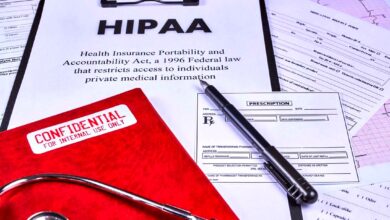Navigating Occupational Exposure Claims: Understanding Your Legal Rights and Options

Occupational exposure to hazardous substances or unsafe working conditions can lead to serious health issues, affecting not just your ability to work but also your overall quality of life. Whether it’s exposure to chemicals, asbestos, excessive noise, or other harmful agents, the consequences can be life-altering. Understanding your legal rights and the avenues available for recourse is the first step toward securing your health and financial future. This article is designed to navigate you through the essentials of occupational exposure claims, from identifying hazards to filing a claim effectively.
Read More: 5 Signs That Tell You It’s Time to See an Employment Lawyer ASAP
Identifying Occupational Hazards
The foundation of any occupational exposure claim is the ability to identify and document the hazards present in the workplace. This involves understanding the various types of risks that can lead to occupational diseases or injuries. Common hazards include toxic chemical exposure, repetitive motion injuries, and unsafe working conditions leading to accidents. Workers should document any known exposure to harmful substances, noting the duration and intensity of exposure. Keeping a detailed record, including any safety violations and your health status over time, is crucial. This initial step is not just about recognizing the risks but also about laying the groundwork for a potential claim.
The Importance of Legal Assistance
Navigating occupational exposure claims can be a tricky task, laden with legal complexities and procedural nuances. To effectively manage this process, it is advisable to locate a lawyer to help you with the intricacies of navigating through your claim. An experienced attorney can provide invaluable guidance, helping you to understand the particulars of your claim and the legal system. A lawyer specializing in occupational exposure and workers’ compensation can assess your case, advise on the best course of action, and represent your interests throughout the claim process.
Understanding Workers’ Compensation
Workers’ compensation is a form of insurance providing wage replacement and medical benefits to employees injured in the course of employment. Understanding how this system works is crucial for anyone filing an occupational exposure claim. It’s important to know what injuries or illnesses are covered, the process for filing a claim, and what benefits you’re entitled to receive. However, workers’ compensation also has its limitations, and in some cases, it may not fully cover the extent of your injuries or occupational diseases. This segment will delve into the nuances of workers’ compensation, highlighting its benefits and limitations and why securing legal assistance may be necessary for certain cases.
Filing an Occupational Exposure Claim
Filing an occupational exposure claim is a process that requires attention to detail and adherence to specific procedures. From the moment you realize you’ve been exposed to a hazardous substance or condition, it’s vital to report the injury or illness to your employer as soon as possible. This segment will guide you through the step-by-step process of filing your claim, including how to properly document your exposure and injuries, the importance of medical evidence, and the deadlines you need to meet. Timely and accurate filing is key to ensuring your claim is considered valid and processed without unnecessary delays.
Gathering Evidence for Your Claim
A successful occupational exposure claim often hinges on the strength of the evidence presented. This section emphasizes the types of evidence crucial to supporting your claim, such as medical records, expert testimonials, and documentation of workplace conditions. Medical evidence should detail the nature and extent of your injuries or illness, linking them directly to your workplace exposure. Additionally, testimonies from occupational health experts can further substantiate your claim, providing insight into how the exposure occurred and its impact on your health. Gathering comprehensive evidence is fundamental to building a compelling case and achieving a positive outcome.
Once you have filed your occupational exposure claim, understanding what comes next is crucial. The claims process can be lengthy and complex, involving various steps from review to approval or denial. During this time, you may face challenges such as requests for additional information, disputes from your employer or their insurance company, and, potentially, a denial of your claim. This section will guide you through what to expect during the process, offering advice on how to effectively communicate with insurance adjusters and the importance of adhering to all requests for further documentation or evidence. Being prepared for these steps can help you navigate the process more smoothly and improve your chances of a successful claim.
Read More: Companies Shouldn’t Let Employees Consume Excessive Revenue
Legal Options Beyond Workers’ Compensation
Workers’ compensation may not always provide adequate compensation for all damages, especially in cases of severe or long-term injuries and illnesses. This section delves into additional legal avenues that may be available, such as filing a personal injury lawsuit against third parties or pursuing disability benefits. Understanding when and how to explore these options can offer pathways to greater compensation and support. For instance, if a third party’s negligence contributed to your exposure, a personal injury claim could result in a settlement that addresses pain and suffering, something typically not covered by workers’ compensation.
Settlements and Negotiations
Many occupational exposure claims are resolved through settlements. This segment will provide insight into the negotiation process, including how settlements are calculated and what factors can influence the final amount. Understanding the negotiation tactics used by insurance companies and employers, as well as your bargaining power, is key to achieving a fair settlement. An experienced attorney can be invaluable during this phase, ensuring that your rights are protected and that you receive a settlement that truly reflects the impact of your exposure. This section will offer tips on preparing for negotiations, including setting realistic expectations and understanding the long-term implications of your settlement agreement.
Conclusion
Navigating occupational exposure claims is a journey fraught with legal, medical, and procedural complexities. From the initial steps of identifying workplace hazards and seeking legal assistance to navigating the claims process and exploring all possible legal avenues, each stage requires careful attention and informed decision-making. Understanding the role of OSHA, effectively negotiating settlements, and accessing long-term support are all crucial elements in ensuring that you receive the compensation and assistance you deserve. Armed with knowledge and the right support, you can confidently advocate for your rights and secure a future that acknowledges the impact of your occupational exposure. Remember, while the process may be challenging, you do not have to face it alone. Legal professionals and support networks are available to guide you through, ensuring that your health, well-being, and legal rights are protected every step of the way.











